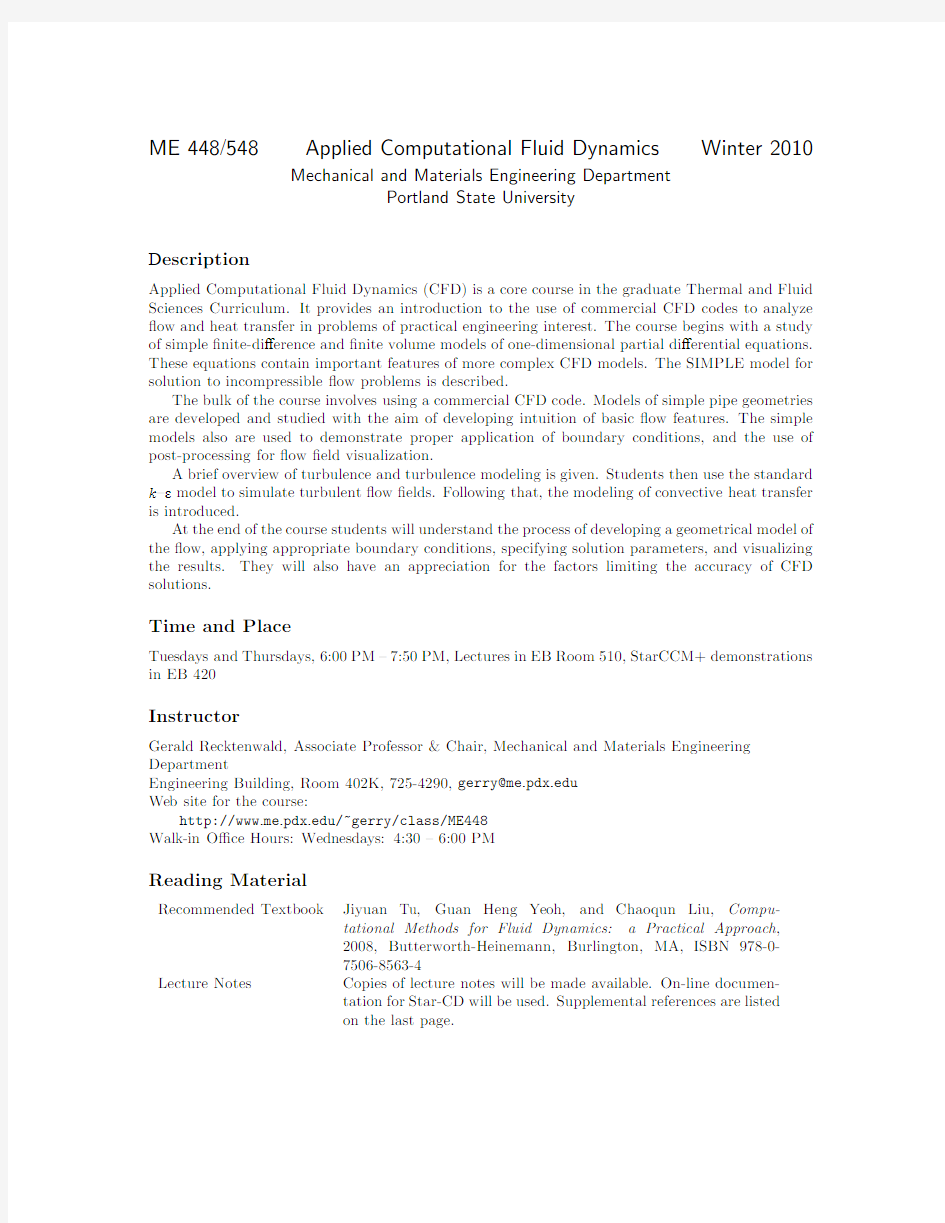syllabus10


ME448/548Applied Computational Fluid Dynamics Winter2010 Mechanical and Materials Engineering Department
Portland State University
Description
Applied Computational Fluid Dynamics(CFD)is a core course in the graduate Thermal and Fluid Sciences Curriculum.It provides an introduction to the use of commercial CFD codes to analyze ?ow and heat transfer in problems of practical engineering interest.The course begins with a study of simple?nite-di?erence and?nite volume models of one-dimensional partial di?erential equations. These equations contain important features of more complex CFD models.The SIMPLE model for solution to incompressible?ow problems is described.
The bulk of the course involves using a commercial CFD code.Models of simple pipe geometries are developed and studied with the aim of developing intuition of basic?ow features.The simple models also are used to demonstrate proper application of boundary conditions,and the use of post-processing for?ow?eld visualization.
A brief overview of turbulence and turbulence modeling is given.Students then use the standard k–εmodel to simulate turbulent?ow?elds.Following that,the modeling of convective heat transfer is introduced.
At the end of the course students will understand the process of developing a geometrical model of the?ow,applying appropriate boundary conditions,specifying solution parameters,and visualizing the results.They will also have an appreciation for the factors limiting the accuracy of CFD solutions.
Time and Place
Tuesdays and Thursdays,6:00PM–7:50PM,Lectures in EB Room510,StarCCM+demonstrations in EB420
Instructor
Gerald Recktenwald,Associate Professor&Chair,Mechanical and Materials Engineering Department
Engineering Building,Room402K,725-4290,gerry@https://www.360docs.net/doc/f213128599.html,
Web site for the course:
https://www.360docs.net/doc/f213128599.html,/~gerry/class/ME448
Walk-in O?ce Hours:Wednesdays:4:30–6:00PM
Reading Material
Recommended Textbook Jiyuan Tu,Guan Heng Yeoh,and Chaoqun Liu,Compu-
tational Methods for Fluid Dynamics:a Practical Approach,
2008,Butterworth-Heinemann,Burlington,MA,ISBN978-0-
7506-8563-4
Lecture Notes Copies of lecture notes will be made available.On-line documen-
tation for Star-CD will be used.Supplemental references are listed
on the last page.
ME4/548Winter20102
Learning Objectives
The Learning Objectives are what I expect that you will be able to do at the end of Quarter.If you can do each of the following activities very well,then you will get an“A”grade.
?Be able to derive the BTCS and FTCS formulation for the one-dimensional heat equation, and perform meaningful computational experiments with sample codes that implement these methods.
?Be able to interpret exact and numerical solutions to the one-dimensional convection-di?usion equation.Be able to explain the relative merits of numerical solutions to this equation obtained with the upwind di?erence scheme and the central di?erence scheme.
?Starting with a rough sketch of a?ow problem,identify all physical data necessary to set up and the solve the velocity,pressure,and temperature?elds using a CFD package.
?Use Star-CD to solve three-dimensional laminar,and turbulent?ow problems.
?Identify whether and when a run of Star-CD has converged.
?Describe the key features of a three-dimensional?ow?eld represented by a vector plot of the velocities,and a contour plot of the pressure?eld.
?Describe the qualitative di?erences between a physical?ow that is turbulent,and the?ow ?eld predicted by a numerical solution to the Reynolds Averaged Navier-Stokes equations. Evaluation
Learning of the course material will be evaluated by grading of homework,exams,and an indepen-dent project.The midterm will have an in-class component and a take-home component.The?nal exam will be comprehensive.Both exams are mandatory.Discuss any potential con?icts well before the exam dates.Make-up exams will not be given.
The independent project,and each homework assignment and exam will be given a numerical grade that is combined to form a cumulative score.The cumulative score is based on the following weights
35%Homework
20%Midterm
25%Project
20%Final Exam
Project
One quarter of the course grade will be based on a project,which involves a detailed simulation of a particular?ow problem.You may chose from a list of projects that have already been identi?ed, or,with instructor approval,you may create your own project.Each student will submit a report and give a brief presentation on their project to the entire class.
ME4/548Winter20103
Supplemental References
The following textbooks are useful references for CFD.
Anderson,Dale A.,Tannehill,John C.,and Pletcher,Richard https://www.360docs.net/doc/f213128599.html,putational Fluid Me-chanics and Heat Transfer,1984,Hemisphere,Washington D.C.
Date,A.N.,Introduction to Computational Fluid Dynamics,2005,Cambridge University Press, New York.
Elman,H.C.,Silvester,D.J.,and Wathen,A.J.,Finite Elements and Fast Iterative Solvers: with applications in incompressible?uid dynamics,Oxford University Press,Oxford,2005.
Ferziger,Joel H.and Peri′c,Milovan,Computational Methods for Fluid Dynamics,third ed., 2001,Springer-Verlag,Berlin.
Hirsch,C.,Numerical Computation of Internal and External Flows,Volume1:The Funda-mentals of Computational Fluid Dynamics,2007,Butterworth-Heinemann,2nd ed.
Lomax,H.,Pulliam T.H.and Zingg,D.W.,Fundamentals of Computational Fluid Dynamics, 2001,Springer-Verlag,New York.
Patankar,Suhas V.,Numerical Heat Transfer and Fluid Flow,1980,Hemisphere,Washington
D.C.
The following textbooks provide useful background for the study of?uid mechanics.
Acheson,D.J.,Elementary Fluid Dynamics,1990,Clarendon Press,Oxford.
Panton,R.L.,Incompressible Flow,third edition,2005,Wiley,New York.
Schey,H.M.,Div,Grad,Curl,and All That,1973,Norton,New York.
Tritton,D.J.,Physical Fluid Dynamics,second edition,1988,Clarendon Press,Oxford.
